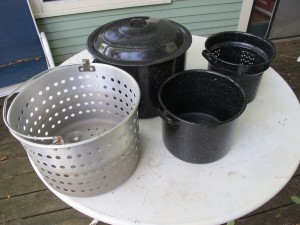Getting Ready for Winter
Summer is nearly over. Those big yellow school buses are beginning their morning ambles and cool nights call for blankets on the bed. It’s time for me to get serious about putting up veggies for the winter.
With the exception of lettuce, most vegetables can be saved for the winter – and beyond. Freezing them is one of the easiest ways of doing so and, if done properly, your veggies will be splendid when cooked and eaten on a cold winter night. But home-frozen vegetables won’t be the texture and flavor you like unless properly prepared. Do small batches to make it easier and quicker.
For starters, only use your best vegetables for freezing. Beans that are oversized and woody when you pick them will only be worse 6 months later. Pick things at their prime, and freeze them within 24 hours of picking. Sitting in the fridge for a few days will not improve them.
Many vegetables have enzymes that promote ripening of seeds – and general aging. Unless you drop them briefly in boiling water to kill those enzymes – a process called blanching – they may get woody or tough. Knowing how long to blanch your vegetables is very important. Boil them too long and you’ll have mushy beans or zucchini. In my experience a brief blanching – a minute or so – is perfect.
It’s worth buying a blanching pot if you want to freeze vegetables. This is an enameled tin pot with an interior pot that is full of holes for drainage. I fill my pot –complete with its inner section – roughly half full of water and bring it to a rolling boil. Then I drop my veggies into the water and time how long they are in, while watching them change color. Vegetables like beans, broccoli and kale will noticeably turn a lighter, brighter green when they are adequately blanched.
Generally 60-90 seconds of blanching is all that is required, even though the water may not even return to a full rolling boil. Use lots of water and not too many veggies for a quick return to boiling. Vegetables should still be crunchy, not mushy when they come out of the hot water. Brussels sprouts take a little longer in the hot water because they are larger and denser than most veggies.
But taking veggies out of the hot water is not enough. You need to cool them quickly in a cold water bath. I fill the sink with cold water and drop them in for a few minutes to cool them quickly, drain them, and spin them in my salad spinner. I like the kind of spinner that has a pull string (mine is a Zyliss brand). Finally I spread them out on a cloth tea towel and blot them with another. They are then ready to go in freezer-grade zipper bags. I always use new bags for freezing, not ones I’ve washed and recycled.
When freezing vegetables it’s a good idea to remove the excess air from the bags. There are machines sold that will do so, but I just use a common drinking straw. I get the bag closed around the straw, suck out the air, and then push the bag shut as I pull out the straw. The bag should cling to the vegetables if done right.
What should you blanch? Beans, beets, broccoli, Brussels sprouts, carrots, cauliflower, corn, kale, spinach, squash and Swiss chard. What does not need it? Apples, pears, peppers, leeks, and tomatoes do not seem to need blanching, in my experience. Tomatoes, beans and Brussels sprouts freeze well whole, the others I cut up. Summer squash freezes well in half-inch cubes and is a great addition to winter soups. Winter squash I often steam or roast, then scoop out of the skins and into bags.
If you haven’t picked your garlic yet, pull it today! If left in the ground too long, the outer skins deteriorate and the garlic won’t store as well. But don’t cut off the tops just yet: let them cure in a dry, shady place. I’ve read that they absorb some nutrients from the stalks and leaves while curing. They store well anywhere – a cool dry spot is good, but you can hang them in the kitchen or keep them in the garage if the garage doesn’t get below freezing. Freezing and thawing would not be good for the garlic.
Onions are ready to harvest when their tops flop over. Like garlic, they need to cure for awhile before storing. Some gardeners just pull them and let them dry in the garden for several days. I prefer to put them on the shady deck to dry out. Then I store them on my wooden drying rack that I got from Gardeners Supply (www.gardeners.com). They sell them as “orchard racks” for $199. It has nine large wooden drawers with excellent ventilation. I generally use mine for onions, garlic and winter squash.
In addition to freezing, I also store potatoes, carrots, kohlrabi and rutabagas in a spare fridge or in a cold cellar with high humidity. I dry fruits, hot peppers and cherry tomatoes in a dehydrator. I do some canning, including my grandmother Lenat’s bread-and-butter pickles and some tomato sauce. But more about all of that on another day. I gotta get down to the garden and pick some veggies!
Henry Homeyer is the author of 4 gardening books and a fantasy-adventure for children. His Web site is www.Gardening-Guy.com.



